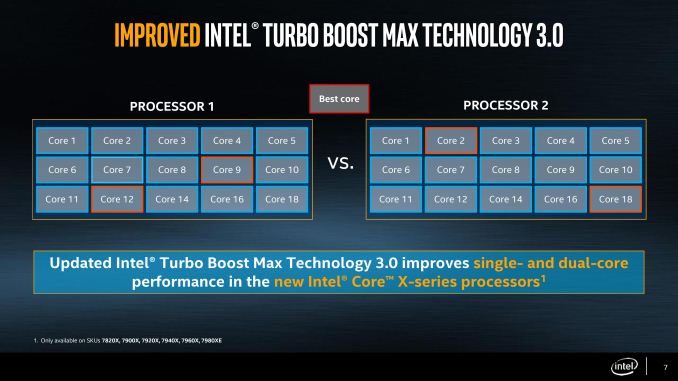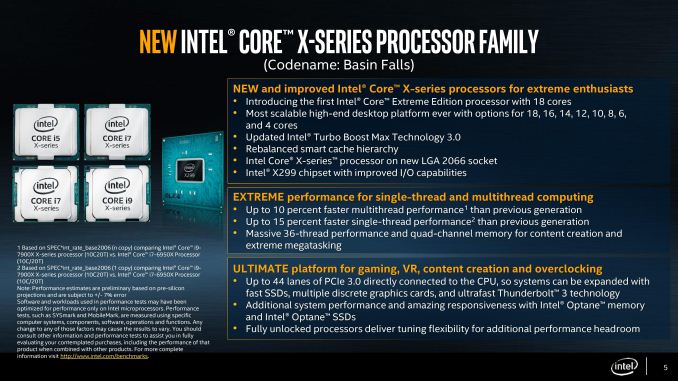Intel Announces Skylake-X: Bringing 18-Core HCC Silicon to Consumers for $1999
by Ian Cutress on May 30, 2017 3:03 AM ESTAnnouncement Four: AVX-512 & Favored Core
To complete the set, there are a couple of other points worth discussing. First up is that AVX-512 support coming to Skylake-X. Intel has implemented AVX-512 (or at least a variant of it) in the last generation of Xeon Phi processors, Knights Landing, but this will be the first implementation in a consumer/enterprise core.
Intel hasn’t given many details on AVX-512 yet, regarding whether there is one or two units per CPU, or if it is more granular and is per core. We expect it to be enabled on day one, although I have a suspicion there may be a BIOS flag that needs enabling in order to use it.
As with AVX and AVX2, the goal here is so provide a powerful set of hardware to solve vector calculations. The silicon that does this is dense, so sustained calculations run hot: we’ve seen processors that support AVX and AVX2 offer decreased operating frequencies when these instructions come along, and AVX-512 will be no different. Intel has not clarified at what frequency the AVX-512 instructions will run at, although if each core can support AVX-512 we suspect that the reduced frequency will only effect that core.
With the support of AVX-512, Intel is calling the Core i9-7980X ‘the first TeraFLOP CPU’. I’ve asked details as to how this figure is calculated (software, or theoretical), but it does make a milestone in processor design. We are muddying the waters a bit here though: an AVX unit does vector calculations, as does a GPU. We’re talking about parallel compute processes completed by dedicated hardware – the line between general purpose CPU and anything else is getting blurred.
Favored Core
For Broadwell-E, the last generation of Intel’s HEDT platform, we were introduced to the term ‘Favored Core’, which was given the title of Turbo Boost Max 3.0. The idea here is that each piece of silicon that comes off of the production line is different (which is then binned to match to a SKU), but within a piece of silicon the cores themselves will have different frequency and voltage characteristics. The one core that is determined to be the best is called the ‘Favored Core’, and when Intel’s Windows 10 driver and software were in place, single threaded workloads were moved to this favored core to run faster.
In theory, it was good – a step above the generic Turbo Boost 2.0 and offered an extra 100-200 MHz for single threaded applications. In practice, it was flawed: motherboard manufacturers didn’t support it, or they had it disabled in the BIOS by default. Users had to install the drivers and software as well – without the combination of all of these at work, the favored core feature didn’t work at all.
Intel is changing the feature for Skylake-X, with an upgrade and for ease-of-use. The driver and software are now part of Windows updates, so users will get them automatically (if you don’t want it, you have to disable it manually). With Skylake-X, instead of one core being the favored core, there are two cores in this family. As a result, two apps can be run at the higher frequency, or one app that needs two cores can participate.
Availability
Last but not least, let's talk about availability. Intel will likely announce availability during the keynote at Computex, which is going on at the same time as this news post goes live. The launch date should be sooner rather than later for the LCC parts, although the HCC parts are unknown. But no matter what, I think it's safe to say that by the end of this summer, we should expect a showdown over the best HEDT processor around.


















203 Comments
View All Comments
Kevin G - Tuesday, May 30, 2017 - link
I wonder how much of that performance gain is just higher clock speed or software optimization (AVX-512).Meteor2 - Saturday, June 3, 2017 - link
It's funny that they slipped that in; with the biggest performance jump in Intel chips in years just around the corner, it's a bad time to buy Kaby Lake.lefty2 - Tuesday, May 30, 2017 - link
" I wouldn’t be surprised if the 10-core $1721 part was the bestselling Broadwell-E processor. "I would. That price excludes it from the enthusiast market anyway (I know that from looking at distributor sales figures).
I'm just wondering what this product is used for. Who needs 18 cores and is will to pay $2000 for it and what application are they running on it?
damianrobertjones - Tuesday, May 30, 2017 - link
There doesn't have to be a need to achieve, "I'm da' Bomb and own this SUCKAZ!"kinopro123 - Tuesday, May 30, 2017 - link
Have you heard of the film and tv editing industry? It's not exactly small. And that's just one industry that requires high IPC + multithreading, where machines are an essential part of the workflow -- hence pay for themselves. There are studio computers with a dual Xeon and seven GPU's -- no consumer could afford it, because they're not really for normal consumers..smilingcrow - Tuesday, May 30, 2017 - link
The Pro market tend to go Xeon for the fuller feature set so the question is how many consumers will spend over a grand on a CPU?Kevin G - Tuesday, May 30, 2017 - link
The film/video market only goes Xeon if their workloads need more memory than what a single socket with non-registered memory can provide or the additional PCIe links for IO. The rest of the Xeon feature set is generally lost in that market segment.As for the real consumers, best probably to look back a little over a decade to see how well the Gallatin based Pentium 4 Extreme edition sold with its extra 2 MB of L3 cache. That's the last time Intel felt this threatened as they used a Xeon MP die for a consumer part. We're seeing this again with the middle Xeon die being brought into consumer form. Not a bad thing.
Namisecond - Wednesday, May 31, 2017 - link
I would suggest "as many people who would spend over a grand on a GPU"TEAMSWITCHER - Tuesday, May 30, 2017 - link
The DESKTOP PC market is on it's last legs. These products are not about what you can do wth a computer ... but rather what kind of computer you can merely own.Notmyusualid - Tuesday, May 30, 2017 - link
Oh yeah, I wish I could trade in my 14C/28T to browse on my smartphone...